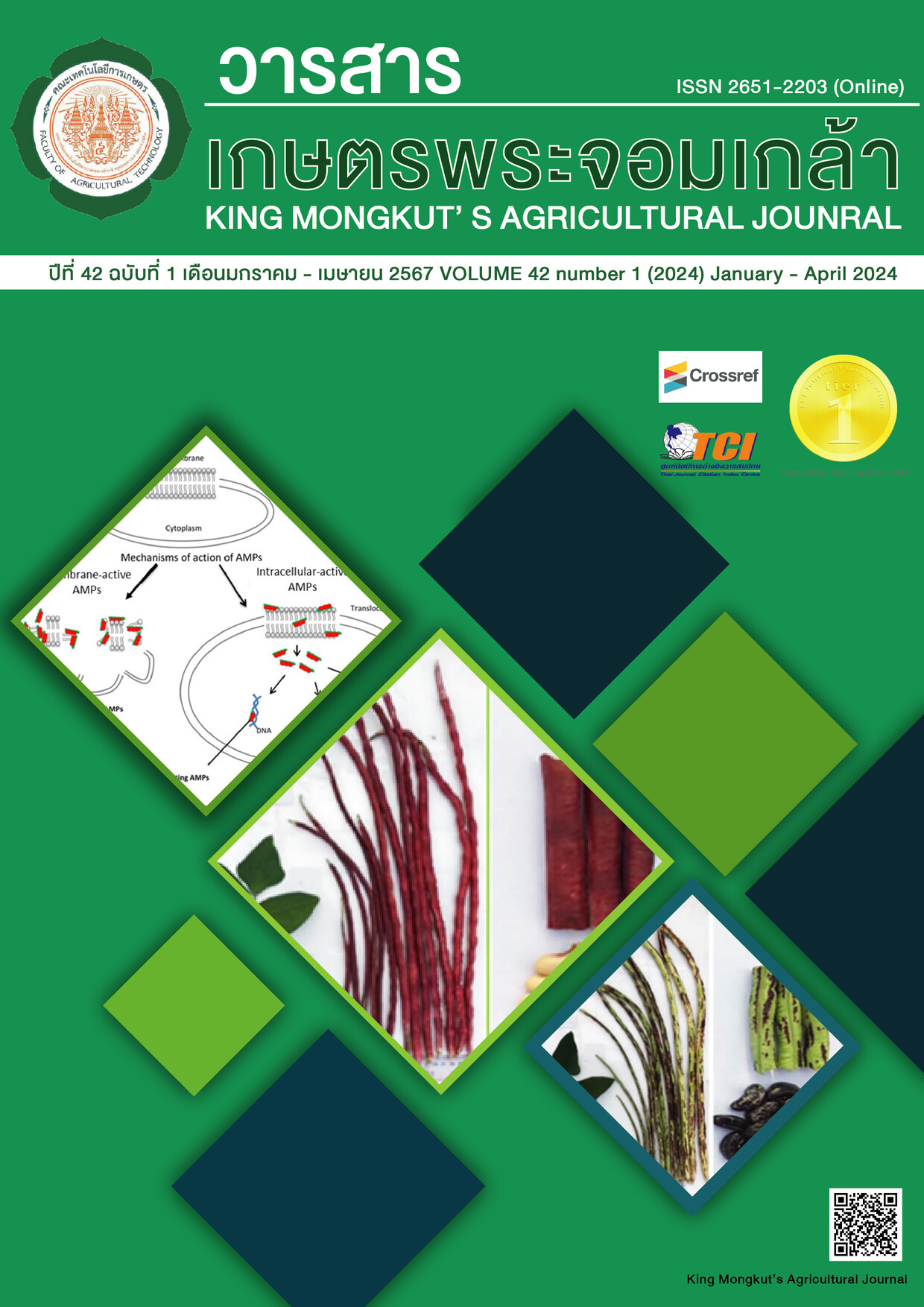ผลของไบโอชาร์ต่อการเปลี่ยนแปลงความอุดมสมบูรณ์ของดินร่วนปนทรายและดินเหนียว ในสภาพโรงเรือน
Main Article Content
บทคัดย่อ
ไบโอชาร์ที่ได้จากวัสดุเหลือใช้ทางการเกษตรสามารถนำมาปรับปรุงบำรุงดิน เพื่อยกระดับความอุดมสมบูรณ์ของดินทั้งทางด้านเคมี กายภาพและชีวภาพของดิน เพื่อให้ทราบถึงผลของไบโอชาร์ต่อการเปลี่ยนแปลงความอุดมสมบูรณ์ของดินเหนียวและดินร่วนปนทรายในสภาพโรงเรือน ใช้แผนการทดลองแบบ 2x5 Factorial in RCB มี 4 ซ้ำ ปัจจัยที่ 1 คือ เนื้อดิน (texture) 2 ชนิด ได้แก่ 1) ดินเหนียว (clay soil-Cl) 2) ดินร่วนปนทราย (sandy loam soil-SL) ปัจจัยที่ 2 คือ ไบโอชาร์ (biochar-BC) 5 ระดับ ได้แก่ 0 16 32 48 และ 64 กรัมต่อดิน 10 กิโลกรัม (0.5, 1.0, 1.5 และ 2.0 ตันต่อไร่ โดยประมาณ) ทุกตำรับการทดลองใส่ปุ๋ยไนโตรเจน ฟอสเฟตและโพแทชตามค่าวิเคราะห์ดิน ผลการทดลองพบว่า การใช้ไบโอชาร์ในดินเหนียวทำให้ปริมาณธาตุอาหารที่เป็นประโยชน์ในดินและการดูดใช้ธาตุอาหารทั้งหมดในตอซังสูงกว่า (p<0.01) การใช้ไบโอชาร์ในดินร่วนปนทรายและส่งผลให้ข้าวโพดมีการเจริญเติบโตและผลผลิตน้ำหนักแห้งตอซังเพิ่มขึ้น (p<0.01) อีกทั้งพบว่าปริมาณอินทรียวัตถุและโพแทสเซียมที่แลกเปลี่ยนได้ในดินสูงกว่าดินร่วนปนทรายที่ใส่ไบโอชาร์ (p<0.01) อย่างไรก็ตาม ปริมาณฟอสฟอรัสที่เป็นประโยชน์ในดินต่ำกว่าดินร่วนปนทราย นอกจากนี้ การใส่ไบโอชาร์ปรับปรุงดินมีผลทำให้ปริมาณการสะสมของไนเตรทในดินเหนียวและดินร่วนปนทรายเพิ่มสูงกว่าดินที่ไม่ใส่ไบโอชาร์ จากผลการทดลองอาจกล่าวได้ว่าควรใช้ไบโอชาร์ในการเพิ่มความอุดมสมบูรณ์ให้กับดินเหนียวมากกว่าดินร่วนปนทราย โดยใช้ในอัตรา 1.5 ตันต่อไร่
Article Details

อนุญาตภายใต้เงื่อนไข Creative Commons Attribution-NonCommercial-NoDerivatives 4.0 International License.
วารสารเกษตรพระจอมเกล้า
เอกสารอ้างอิง
Agricultural Production Sciences Research and Development Office. (2008). Organic Fertilizer Analysis Manual. Agricultural Production Sciences Research and Development Office. (in Thai).
Angmanee, R., Chuangcham, K., & Homchan, U. (2017). Properties of Corn Waste Biochar and Potential for Soil Improvement. VRU Research and Development Journal Science and Technology, 12(1), 53-63. (in Thai).
Arabi, Z., Eghtedaey, H., Gharehchmaghloo, B., & Faraji, A. (2018). Effects of biochar and bio-fertilizer on yield and qualitative properties of soybean and some chemical properties of soil. Arabian Journal of Geosciences, 11, 1-9.
Bol, R., Amelun, W., Friedrich, C., & Ostle, N. (2000). Tracing dung-derived carbon in temperate grassland using 13C natural abundance measurements. Soil Biology & Biochemistry, 32, 1337-1343.
Borchard, N., Schirrmann, M., Cayuela, M. L., Kammann, C., Wrage-Mönnig, N., Estavillo, J. M., Fuertes-Mendizábal, T., Sigua, G., Spokas, K., Ippolito, J. A., & Novak, J. (2019). Biochar, soil and land-use interactions that reduce nitrate leaching and N2O emissions: A meta-analysis. Science of the Total Environment, 651, 2354-2364.
Bray, R. H., & Kurtz, L. T. (1945). Determination of total, organic and available forms of phosphorus in soil. Soil Science, 59, 39-45.
Bremner, J. M. (1960). Determination of nitrogen in soil by the Kjeldahl method. Journal of Agricultural Science, 55, 11-33.
Davis, L. E. (1943). Measurements of pH with the glass electrode as affected by soil moisture. Soil Science, 56(6), 405-422.
Dempster, D. N., Jones, D. L., & Murphy, D. M. (2012). Clay and biochar amendments decreased inorganic but not dissolved organic nitrogen leaching in soil. Soil Resource, 50, 216-221.
Department of Agriculture. (2001). Soil and Plant Analysis Manual. Department of Agriculture. (in Thai).
Fidel, R. B., Laird, D. A., & Spokas, K. A. (2018). Sorption of ammonium and nitrate to biochars is electrostatic and pH-dependent. Scientific Reports, 1-10.
Laird, D., Fleming, P., Wang, B., Horton, R., & Karlen, D. (2010). Biochar impact on nutrient leaching from a Midwestern agricultural soil. Geoderma, 158, 436-442.
Liang, B., Lehmann, J., Solomon, D., Kinyang, J., Grossman, J., O'Neill, B., Skjemstad, J. O., Thies, J., Luizão, F. J., Petersen, J., & Neves, E. G. (2006). Black carbon increases cation exchange capacity in soils. Soil Science Society of American Journal, 70(5), 1719-1730.
Major, J., Rondon, M., Molina, D., Riha, S. J., & Lehmann, J. (2010). Maize yield and nutrition during 4 years after biochar application to a Colombian savanna oxisol. Plant Soil, 333, 117-128.
Mewong, S. (2014). Effects of Bamboo and Rice Husk Biochars on Yield and Nitrogen Use Efficiency of Chainat 1 Rice. Retrieved from: https://li01.tci-thaijo.org/index.php/sci_ubu/article/view/87198/68959. (in Thai).
Office of Agricultural Economics. (2022). Production factor.
Retrieved from: http://www. https://www.oae.go.th/view/1/TH-TH. (in Thai).
Onthong, J. (2004). Soil and Plant Analysis Manual. Faculty of Natural Resources, Prince of Songkhla University. (in Thai).
Pornamnuaylap, D., & Suaysom, W. (n.d). Effect of Biochar on the Growth and Yield of Maize on Sloping Land In Soil Series Group No.55, Nan Province. Retrieved from: http://www.ldd.go.th/LDDCon65/data/02/2-2.pdf. (in Thai).
Prendergast-Millera, M. T., Duvalla, M., & Sohi, S. P. (2014). Biochar–root interactions are mediated by biochar nutrient
content and impacts on soil nutrient availability. European Journal of Soil Science, 65, 173-185.
Puttanakul, P., Soydoa, V., & Sivawan, P. (2019). Effect of plant residues and biochars on organic matter and nitrogen
retention in soil. Science and Technology Silpakorn University, 6(6), 40-55. (in Thai).
Rubin, R. L., Anderson, T. R., & Ballantine, K. A. (2020). Biochar Simultaneously Reduces Nutrient Leaching and Greenhouse
Gas Emissions in Restored Wetland Soils. Retrieved from: https://www.researchgate.net/publication/344476897_Biochar_Simultaneously_Reduces_Nutrient_Leaching_and_Greenhouse_Gas_Emissions_in_Restored_Wetland_Soils.
Saelim, S. (2016). Organic Fertilizer and Utilization in Thailand. Division of Soil Biotechnology. (in Thai).
Sohi, S., Lopez-Capel, E., Krull, E. & Bol, R. (2009). Biochar, Climate Change and Soil: A Review to Guide Future Research. Retrieved from:https://www.researchgate.net/publication/228656328_Biochar_Climate_Change_and_Soil_A_Review _to_Guide_Future_Research/
Sun, L., Li, L., Chen, Z., Wang, J., & Xiong, Z. (2014). Combined effects of nitrogen deposition and biochar application on emission of N2O, CO2 and NH3 from agricultural and forest soils. Soil Science and Plant Nutrition, 60, 254-265.
Wachiratanusorn, S. (2018). Effect of Chicken Manure and Biochar on Soil Properties, Growth and Yield Of Green Oak Lettuce Growing in Acid Soil. Master’s thesis. Thammasat University. (in Thai).
Walkey, A., & Black, I. A. (1934). An examination of Degtjareff method for determining soil organic matter and a proposed
modification of the chronic acid titration method. Soil Science, 37, 29-38.
Widowati & Asnah. (2014). Biochar effect on potassium fertilizer and leaching potassium dosage for two corn planting
seasons. Journal of Agricultural Science, 36(1), 65-71.
Widowati, Asnah, & Utomo, W. H. (2018). The use of biochar to reduce nitrogen and potassium leaching from soil
cultivated with maize. Journal of Degraded and Mining Lands Management, 2(1), 211-218.
Xu, G., Sun, J. N., Shao, H. B., & Chang, S. X. (2014). Biochar had effects on phosphorus sorption and desorption in three soils
with differing acidity. Ecological Engineering, 62, 54-60.
Xu, N., Tan, G., Wang, H., & Gai, X. (2016). Effect of biochar additions to soil on nitrogen leaching, microbial biomass and
bacterial community structure. European Journal of Soil Biology, 74, 1-8.
Yu, O. Y., Raichle, B., & Sink, S. (2013). Impact of biochar on the water holding capacity of loamy sand soil. International
Journal of Energy and Environmental Engineering, 4, 1-9.
Zhao, P., Wang, S., Liu, D., Li, H., Han, S., & Li, M. (2022). Study on influence mechanism of biochar on soil nitrogen
conversion. Environmental Pollutants and Bioavailability, 34(1), 419-432.


